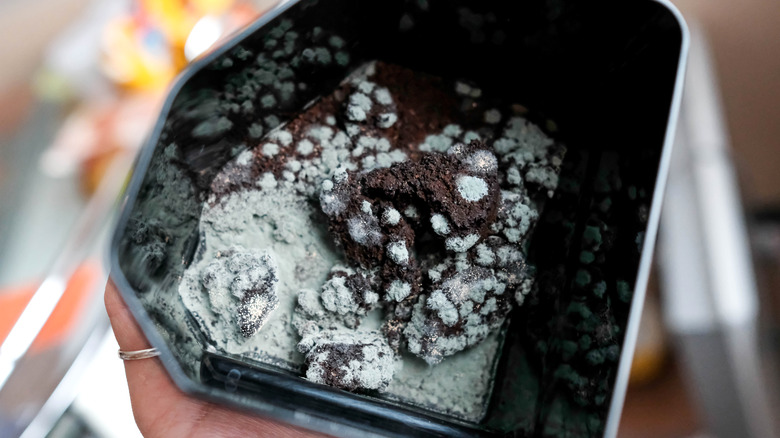The Real Reason Your Coffee Maker Might Be Making You Sick
Have you been feeling a bit run-down lately? Are you tired all the time, even after you've had that first (and second) cup of coffee? Well, it may actually be the coffee itself that's making you sick — or rather, the machine in which you made it. Michael Rubino, president of All American Restoration and author of "The Mold Medic," explains to Mashed that chronic fatigue and brain fog can be symptoms of mold exposure, as can red or itchy eyes, a scratchy throat, skin rashes, and a cold that just won't go away no matter what.
Should you be exposed to, or ingesting, mold on a regular basis, Rubino warns that you could also be at risk of neurological and neuropsychiatric symptoms including problems with balance and coordination, delirium, and dementia. While he admits that medical science doesn't yet know all of the health risks posed by mold, he says they do know it's not a good thing ... and you could be downing a daily dose of it due to your dirty coffee maker.
How mold gets into your coffee maker
While Rubino says that the main way mold gets into our bodies is when we breathe it in due to some type of indoor contamination, we can also ingest mold through what we eat or drink. "Coffee is no exception to this," he tells Mashed. Rubino points out that there are some companies that will test the coffee they sell for mycotoxins — that is, toxins produced by mold commonly found in food, per WHO — before they package it. Buying mold-free coffee is a good thing, but Rubino says the product is only part of the equation.
If you are putting the purest, freshest, finest coffee into your coffee maker, you could still wind up with a hot cup o'mold if the coffee maker itself is dirty inside. The water could pick up mold spores as it passes through the machine, and what's worse, you may not even know the mold is there. As Rubino explains, "Coffee is a strong taste all on its own so you may not immediately notice it!"
How to clean your coffee maker
Okay, well, that's just gross. But what if you do wash out your coffee pot on a regular basis, could it still possibly be moldy? Quite easily, says Rubino. In order to get your coffee maker really clean, he says you'll need to be practically dissecting it each and every day. "In my house," he says, "we make it a good practice to clean the coffee maker every night and allow the parts that disassemble an opportunity to air dry before making coffee fresh the next day."
Rubino advises hand-washing all of the coffee maker's removable parts (the tray, the reservoir) with soap and water and then letting them dry thoroughly before re-assembling them. He also says to wipe down the outside of the machine with a disinfectant. You should also empty the reservoir each day and never allow water to sit overnight. According to a study by independent public health organization NSF International, the coffee reservoir is one of the germiest surfaces in the entire house, with nearly 50% of households having mold spores found in this area. If you adopt a cleaning routine like Rubino's, he says it will allow you to "remov[e] settled spores before they have an opportunity to meet with the stagnant water and start to grow and colonize."
Your coffee maker won't last forever
One factor that will impact your coffee maker's ability to add mold to your daily cup(s) of java is the age of the machine. Doesn't the coffee taste just a bit different now than it did when your coffee maker was fresh out of the box? Rubino explains that coffee makers are really only good for a couple of years, tops. The reason, he explains, is that "the appliance has a lot of internal hoses, gaskets, and other parts that you cannot clean," breaking it to us that "over time, the opportunity for mold to grow in there is likely." These internal parts, he says, are in constant contact with moisture, and are unlikely to dry out on their own. Whenever stagnant water is in contact with a surface for as little as 24 hours, this presents an opportunity for mold to grow.
Even if you follow a coffee maker cleaning regimen as rigorous as Rubino's, you'll still need to replace your coffee maker on a regular basis. He says the cleaning is "only prolonging the machine's useful life," and reveals that it took just four years for his machine to grow moldy despite his precautions. "Even with all of the rigorous cleaning and drying of the internal parts," he admitted, "one morning my cup of coffee tasted like it had brewed inside of a mold factory." Better start checking for sales on kitchen appliances!



